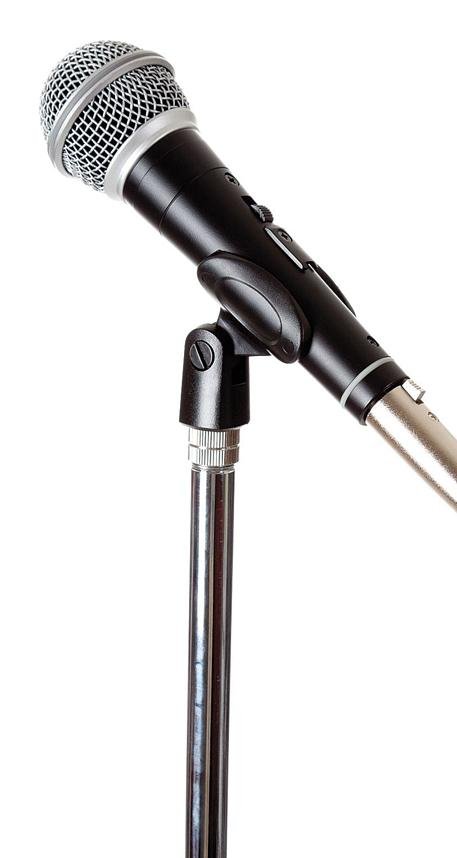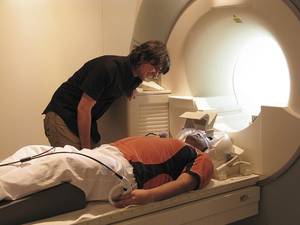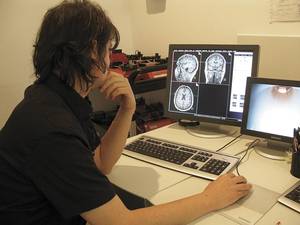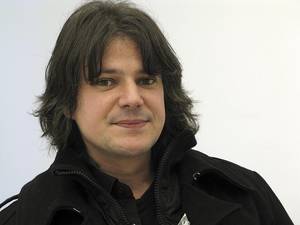Rhymes in the scanner

In fact, the idea of investigating arises from a real movie. Film director Asier Altuna filmed the documentary Bertsolari, met the Basque Center on Cognition, Brain and Language (BCBL) research centre and thought they could investigate the brain functioning of bertsolaris. He told the protagonist of the film, bertsolari Andoni Egaña, and he also found it interesting. So, they went to the BCBL, where they got a better response than expected. In fact, "researchers took our idea seriously," Egaña recalled.
From the BCBL's point of view, however, it is no wonder that Altuna and Egaña's proposal was taken seriously. In fact, one of the main objectives of BCBL is the clarification of the neurocognitive mechanisms that intervene in the production of language, an aspect in which there was already a great curiosity for bertsolarism. Thus, the challenge of the investigation remained "full of desire", said the director of the center, Manuel Carreiras.
What should be a striking or curious scene of a film became scientific research. The study, led by Kepa Paz Alonso, had no doubt that the first visit was the possibility of conducting an in-depth study: "Planning research, designing tests and preparing an MRI machine is not easy. So, as we had to do for the film Bertsolari, why not take advantage of that work to do extensive research with more participants? ". The Bertsozale Association also saw the project with good eyes and set out together.
Paz Alonso explains the fate: "Within cognitive neuroscience, it is common to compare groups with different levels of skill in a given activity. In this case, we will compare people who are specialists in the creation of bertsos (bertsolaris), who are forming in this type of creation (students of the bertso-eskolas) and who do not, to see what particularity bertsolaris have with respect to others".
However, he clarified that they will not answer the classical question about bertsolarism, if bertsolari is made or born: "Many have asked us if we are going to analyze this issue, but it is not our intention at all. In any case, Andoni Egaña states that bertsolari, like any other, must be born first and then done. I, to tell the truth, have no data on this issue, but I agree that formation, Berthsolarism, has much to say in the ability to create verses, and at least research will serve to confirm or cancel it."
As the researcher has pointed out, "there may be new questions at the end of the investigation," but in principle they have some questions that they would like to answer: "For example, it is clear that bertsolaris have more ability than us to make lists of rhyming words. Why is that because they keep them in a special way in memory, or bring them in a very effective way when they remember them? We want to answer these kinds of questions."
You are also interested in analyzing working memory: "We call working memory to online information conservation and the ability to perform complex operations. The bertsolaris have that very developed capacity and we want to see how they do it and what differences they have with those who have that skill so developed or less trained."
Computer and MRI
In this sense, Paz Alonso has designed three tests: "the first two will have to be realized by all, and the last, only by the bertsolaris, because we ask them to believe bertsos, and that, of course, only they can do it".
The first computer test aims to measure the main cognitive functions: reasoning, speed of information processing, attention to relevant information and inhibition of distraction, memory, etc. The other two have been performed using functional MRI to see which brain networks are activated in the different aspects of linguistic production.
Paz Alonso explains how MRI tests are: "The first is to perform phonological, semantic and rimal exercises of different degree of difficulty. It is clear that the bertsolaris will be better than the others in the elaboration of lists of words with a certain end, but we want to see if the strategy they use for this brings advantages in other areas, for example, to make lists of words with the same syllable, or to give words of the same semantic field".
Finally, in the second MRI test, volunteers have to make bertsos. For this, they give them theme, melody and size and analyze what happens in each phase of the creation of bertsos: "at the moment when the bertsolari listens to the subject, thinks the bertso and while singing," said Paz Alonso.
The researcher recognizes that the exercise is limited compared to what they do in squares or in competition, but to obtain significant results it is necessary that the exercises be detailed and that everyone perform the same exercises. Therefore, they have only had to act in two measures: coplas and zortziko txikia. The songs were 30, some easier than others, with their melodies defined and their times to think and sing. "It's about testing being as standardized as possible so that the MRI data is comparable."

In addition, to measure the quality of the verses they have transcribed the verses issued in the tests and will be judged by a team of judges of the Bertsolaris Association. "This is also important, not only to relate the quality of the verses to the resonance images, but to motivate the bertsolaris and encourage them to make the best possible verses."
Bertsolaris, students and others
In addition to Andoni Egaña, 17 other bertsolaris participated in the study. Jon Agirresarobe, of the Bertsozale Association, has been in charge of the coordination of the participants and has stated that it has not been so easy to choose the participants: "Not because they wanted to participate, but because they had to meet very specific conditions."
For example, his mother tongue should be Basque; "this left out quite a few young bertsolaris", said the coordinator. Moreover, they could not be left, "it seems that their brain doesn't work like those who are right."
However, he managed to select a relatively high number of bertsolaris who score in squares and championships, and all who have been proposed to perform the tests, including Gipuzkoa champion Aitor Sarriegi: "They asked us if we would be willing to participate in one way or another, and the truth is that I didn't think twice. I also took it with curiosity. I find it very attractive to see how it works, with a scientific guarantee."
The bertsolaris group has already carried out the tests and now two other groups are missing. Now they are looking for volunteers for them. According to Agirresarobe, "this is not entirely easy either, since I have to find someone similar to each bertsolari, both among the students of bertsolaris schools and among the Euskaldunzaharras who are not engaged in bertso." That is, in sex, in age, in the usual use of language, in the sociological environment, in the intellectual plane... they have to be equal to the bertsolaris, except in the ability to verse.

First brushstrokes
Until all volunteers have done the tests and compared the results, they will not be able to draw definitive conclusions, but in the meantime, they have already seen some things, not only the researchers but also the bertsolaris themselves. For example, Egaña realizes that having the words ordered according to rhyme helps other exercises that apparently have nothing to do with it.
Paz Alonso said that this also happens with other skills, since some of the strategies they use to be experts in something are also useful in other areas: "For example, asking me to say words starting with the letter K, many of the words spoken by the bertsolaris made rhyme. It is evident, therefore, that they use the same strategy as the words that rhyme to perform this phonological exercise. However, those who don't make berths don't have that advantage."
It advances some aspects that hope to appear in the first results: "Among other things, we want to see if differences appear in the activation of the brain depending on the nature of the verse. For example, we believe that the freshness of the verse may be related to cortical and subcortical zones."
Another stroke: "Although it is still very early to move forward, we are seeing in resonance imaging that sometimes spaces related to sight are activated, even when they are not receiving visual stimuli, for example, when thinking the bertso. It may be because they are seeing the sense of the bertso, or because they are representing rhyming words. They are still hypotheses."
The researcher has stated that the rest of the volunteers will take a few months to carry out tests, analyze and compare the results and draw definitive conclusions. But meanwhile, Andoni Egaña explains the wish or hope of the bertsolaris: "We have done what we can, we have responded honestly to the tests and we hope that the consequences that can be derived from it will serve someone and once."
Buletina
Bidali zure helbide elektronikoa eta jaso asteroko buletina zure sarrera-ontzian












